
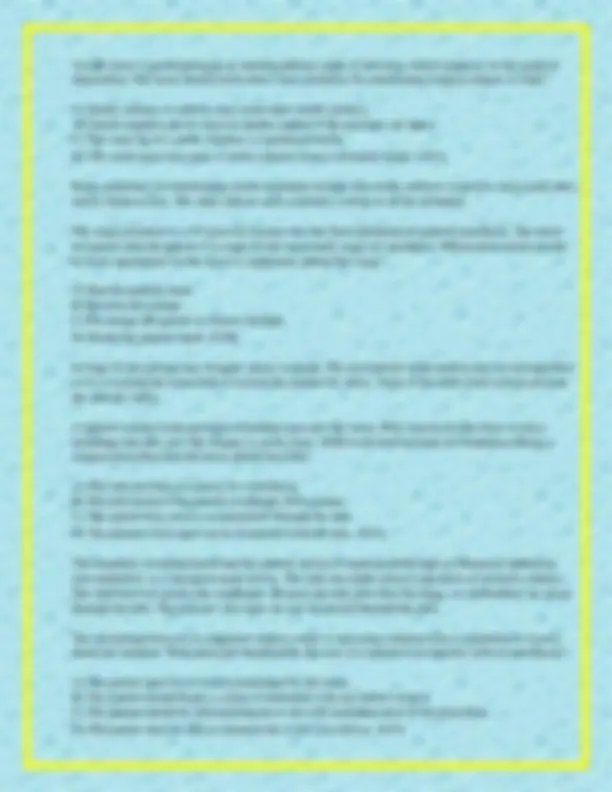
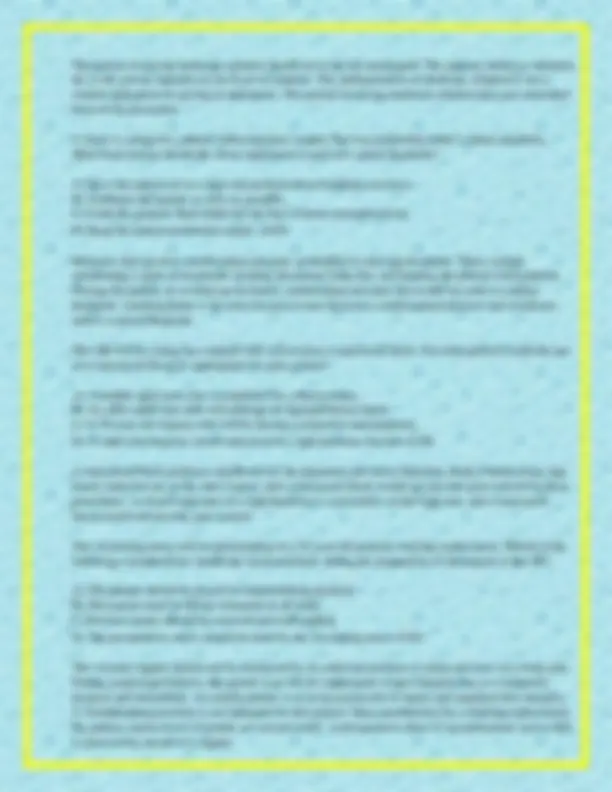
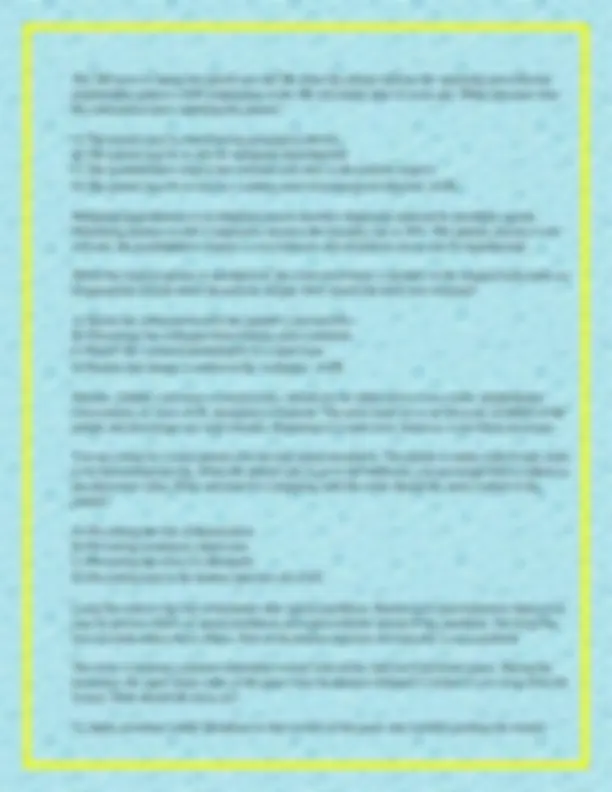
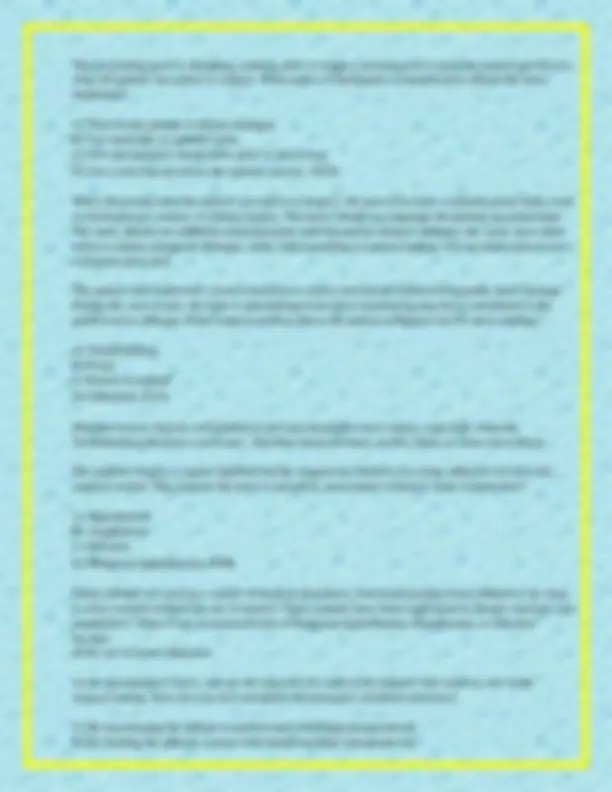
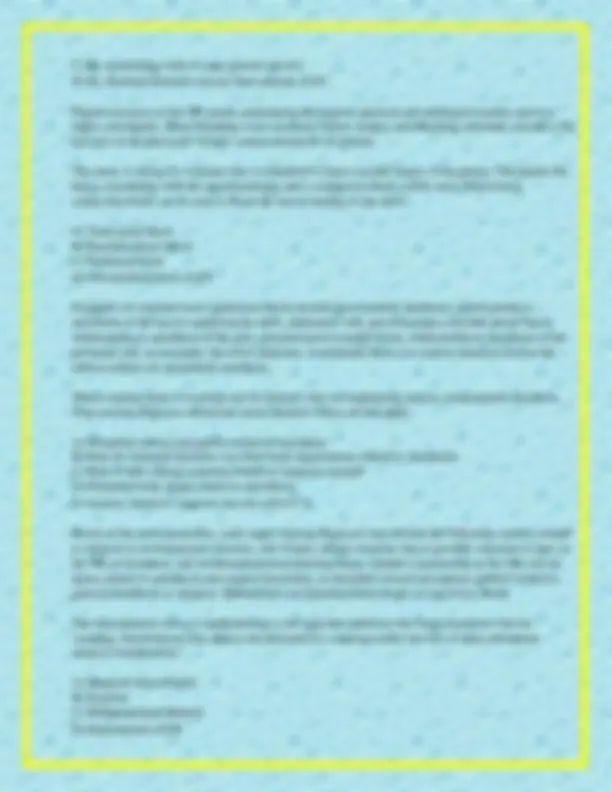
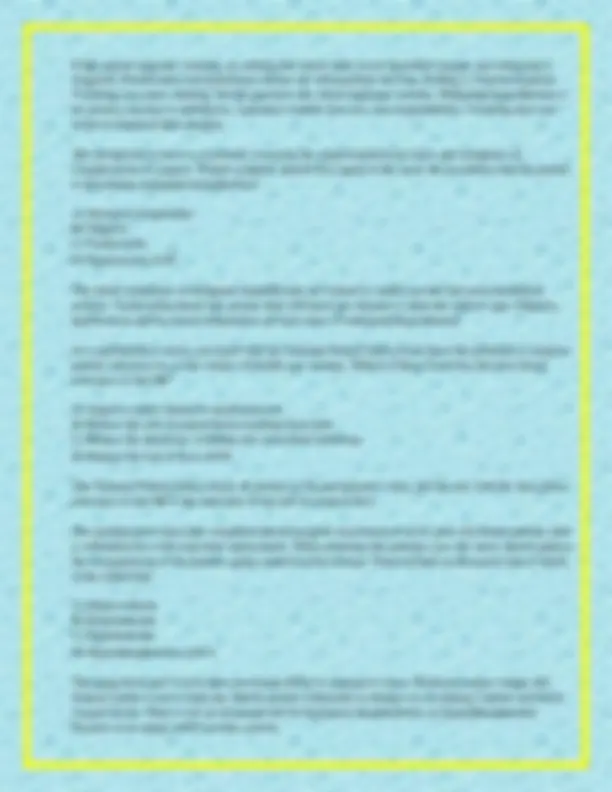



Study with the several resources on Docsity

Earn points by helping other students or get them with a premium plan


Prepare for your exams
Study with the several resources on Docsity

Earn points to download
Earn points by helping other students or get them with a premium plan
Community
Ask the community for help and clear up your study doubts
Discover the best universities in your country according to Docsity users
Free resources
Download our free guides on studying techniques, anxiety management strategies, and thesis advice from Docsity tutors
Chapter 18: Intraoperative Nursing Management
Typology: Exams
1 / 13

This page cannot be seen from the preview
Don't miss anything!








Chapter 18: Intraoperative Nursing Management The nurse is preparing an elderly patient for a scheduled removal of orthopedic hardware, a procedure to be performed under general anesthetic. For which adverse effect should the nurse most closely monitor the patient? A) Hypothermia B) Pulmonary edema C) Cerebral ischemia D) Arthritis ✔✔A Inadvertent hypothermia may occur as a result of a low temperature in the OR, infusion of cold fluids, inhalation of cold gases, open body wounds or cavities, decreased muscle activity, advanced age, or the pharmaceutical agents used (e.g., vasodilators, phenothiazines, general anesthetics). The anesthetist monitors for pulmonary edema and cerebral ischemia. Arthritis is not an adverse effect of surgical anesthesia. The OR nurse acts in the circulating role during a patients scheduled cesarean section. For what task is this nurse solely responsible? A) Performing documentation B) Estimating the patients blood loss C) Setting up the sterile tables D) Keeping track of drains and sponges ✔✔A Main responsibilities of the circulating nurse include verifying consent; coordinating the team; and ensuring cleanliness, proper temperature and humidity, lighting, safe function of equipment, and the availability of supplies and materials. The circulating nurse monitors aseptic practices to avoid breaks in technique while coordinating the movement of related personnel as well as implementing fire safety precautions. The circulating nurse also monitors the patient and documents specific activities throughout the operation to ensure the patients safety and well-being. Estimating the patients blood loss is the surgeons responsibility; setting up the sterile tables is the responsibility of the first scrub; and keeping track of the drains and sponges is the joint responsibility of the circulating nurse and the scrub nurse. A 21-year-old patient is positioned on the OR bed prior to knee surgery to correct a sports-related injury. The anesthesiologist administers the appropriate anesthetic. The OR nurse should anticipate which of the following events as the teams next step in the care of this patient? A) Grounding B) Making the first incision C) Giving blood D) Intubating ✔✔D When the patient arrives in the OR, the anesthesiologist or anesthetist reassesses the patients physical
condition immediately prior to initiating anesthesia. The anesthetic is administered, and the patient airway is maintained through an intranasal intubation, oral intubation, or a laryngeal mask airway. Grounding or blood administration does not normally follow anesthetic administration immediately. An incision would not be made prior to intubation. A circulating nurse provides care in a surgical department that has multiple surgeries scheduled for the day. The nurse should know to monitor which patient most closely during the intraoperative period because of the increased risk for hypothermia? A) A 74-year-old woman with a low body mass index B) A 17-year-old boy with traumatic injuries C) A 45-year-old woman having an abdominal hysterectomy D) A 13-year-old girl undergoing craniofacial surgery ✔✔A Elderly patients are at greatest risk during surgical procedures because they have an impaired ability to increase their metabolic rate and impaired thermoregulatory mechanisms, which increase susceptibility to hypothermia. The other patients are likely at a lower risk. The anesthetist is coming to the surgical admissions unit to see a patient prior to surgery scheduled for tomorrow morning. Which of the following is the priority information that the nurse should provide to the anesthetist during the visit? A) Last bowel movement B) Latex allergy C) Number of pregnancies D) Difficulty falling asleep ✔✔B Due to the increased number of patients with latex allergies, it is essential to identify this allergy early on so precautions can be taken in the OR. The anesthetist should be informed of any allergies. This is a priority over pregnancy history, insomnia, or recent bowel function, though some of these may be relevant. An OR nurse is teaching a nursing student about the principles of surgical asepsis as a requirement in the restricted zone of the operating suite. What personal protective equipment should the nurse wear at all times in the restricted zone of the OR? A) Reusable shoe covers B) Mask covering the nose and mouth C) Goggles D) Gloves ✔✔B Masks are worn at all times in the restricted zone of the OR. Shoe covers are worn one time only; goggles and gloves are worn as required, but not necessarily at all times.
The patient receiving moderate sedation should never be left unattended. The patients ability to maintain his or her airway depends on the level of sedation. The administration of moderate sedation is not a counter indication for giving an antiemetic. The patient receiving moderate sedation does not remember most of the procedure. A nurse is caring for a patient following knee surgery that was performed under a spinal anesthetic. What intervention should the nurse implement to prevent a spinal headache? A) Have the patient sit in a chair and perform deep breathing exercises. B) Ambulate the patient as early as possible. C) Limit the patients fluid intake for the first 24 hours postoperatively. D) Keep the patient positioned supine. ✔✔D Measures that increase cerebrospinal pressure are helpful in relieving headache. These include maintaining a quiet environment, keeping the patient lying flat, and keeping the patient well hydrated. Having the patient sit or stand up decreases cerebrospinal pressure and would not relieve a spinal headache. Limiting fluids is incorrect because it also decreases cerebrospinal pressure and would not relieve a spinal headache. The OR will be caring for a patient who will receive a transsacral block. For what patient would the use of a transsacral block be appropriate for pain control? A) A middle-aged man who is scheduled for a thoracotomy B) An older adult man who will undergo an inguinal hernia repair C) A 50-year-old woman who will be having a reduction mammoplasty D) A child who requires closed reduction of a right humerus fracture ✔✔B A transsacral block produces anesthesia for the perineum and lower abdomen. Both a thoracotomy and breast reduction are in the chest region, and a transsacral block would not provide pain control for these procedures. A closed reduction of a right humerus is a procedure on the right arm, and a transsacral block would not provide pain control. The circulating nurse will be participating in a 78-year-old patients total hip replacement. Which of the following considerations should the nurse prioritize during the preparation of the patient in the OR? A) The patient should be placed in Trendelenburg position. B) The patient must be firmly restrained at all times. C) Pressure points should be assessed and well padded. D) The preoperative shave should be done by the circulating nurse. ✔✔C The vascular supply should not be obstructed by an awkward position or undue pressure on a body part. During surgical procedures, the patient is at risk for impairment of skin integrity due to a stationary position and immobility. An elderly patient is at an increased risk of injury and impaired skin integrity. A Trendelenburg position is not indicated for this patient. Once anesthetized for a total hip replacement, the patient cannot move; restraints are not necessary. A preoperative shave is not performed; excess hair is removed by means of a clipper.
The OR nurse is taking the patient into the OR when the patient informs the operating nurse that his grandmother spiked a 104F temperature in the OR and nearly died 15 years ago. What relevance does this information have regarding the patient? A) The patient may be experiencing presurgical anxiety. B) The patient may be at risk for malignant hyperthermia. C) The grandmothers surgery has minimal relevance to the patients surgery. D) The patient may be at risk for a sudden onset of postsurgical infection. ✔✔B Malignant hyperthermia is an inherited muscle disorder chemically induced by anesthetic agents. Identifying patients at risk is imperative because the mortality rate is 50%. The patients anxiety is not relevant, the grandmothers surgery is very relevant, and all patients are at risk for hypothermia. While the surgical patient is anesthetized, the scrub nurse hears a member of the surgical team make an inappropriate remark about the patients weight. How should the nurse best respond? A) Ignore the comment because the patient is unconscious. B) Discourage the colleague from making such comments. C) Report the comment immediately to a supervisor. D) Realize that humor is needed in the workplace. ✔✔B Patients, whether conscious or unconscious, should not be subjected to excess noise, inappropriate conversation, or, most of all, derogatory comments. The nurse must act as an advocate on behalf of the patient and discourage any such remarks. Reporting to a supervisor, however, is not likely necessary. You are caring for a male patient who has had spinal anesthesia. The patient is under a physicians order to lie flat postoperatively. When the patient asks to go to the bathroom, you encourage him to adhere to the physicians order. What rationale for complying with this order should the nurse explain to the patient? A) Preventing the risk of hypotension B) Preventing respiratory depression C) Preventing the onset of a headache D) Preventing pain at the lumbar injection site ✔✔C Lying flat reduces the risk of headache after spinal anesthesia. Hypotension and respiratory depression may be adverse effects of spinal anesthesia associated with the spread of the anesthetic, but lying flat does not help reduce these effects. Pain at the lumbar injection site typically is not a problem. The nurse is packing a patients abdominal wound with sterile, half-inch Iodoform gauze. During the procedure, the nurse drops some of the gauze onto the patients abdomen 2 inches (5 cm) away from the wound. What should the nurse do? A) Apply povidone-iodine (Betadine) to that section of the gauze and continue packing the wound.
optimal patient care and improved outcomes. None of the other listed factors is the basis for the collaboration of the surgical team. An intraoperative nurse is applying interventions that will address surgical patients risks for perioperative positioning injury. Which of the following factors contribute to this increased risk for injury in the intraoperative phase of the surgical experience? Select all that apply. A) Absence of reflexes B) Diminished ability to communicate C) Loss of pain sensation D) Nausea resulting from anesthetic E) Reduced blood pressure ✔✔A B C Loss of pain sense, reflexes, and ability to communicate subjects the intraoperative patient to possible injury. Nausea and low blood pressure are not central factors that contribute to this risk, though they are adverse outcomes. Verification that all required documentation is completed is an important function of the intraoperative nurse. The intraoperative nurse should confirm that the patients accompanying documentation includes which of the following? A) Discharge planning B) Informed consent C) Analgesia prescription D) Educational resources ✔✔B It is important to review the patients record for the following: correct informed surgical consent, with patients signature; completed records for health history and physical examination; results of diagnostic studies; and allergies (including latex). Discharge planning records and prescriptions are not normally necessary. Educational resources would not be included at this stage of the surgical process. A patient will be undergoing a total hip arthroplasty later in the day and it is anticipated that the patient may require blood transfusion during surgery. How can the nurse best ensure the patients safety if a blood transfusion is required? A) Prime IV tubing with a unit of blood and keep it on hold. B) Check that the patients electrolyte levels have been assessed preoperatively. C) Ensure that the patient has had a current cross-match. D) Keep the blood on standby and warmed to body temperature. ✔✔C Few patients undergoing an elective procedure require blood transfusion, but those undergoing high-risk procedures may require an intraoperative transfusion. The circulating nurse anticipates this need, checks that blood has been cross-matched and held in reserve, and is prepared to administer blood. Storing the blood at body temperature or in IV tubing would result in spoilage and potential infection.
The circulating nurse is admitting a patient prior to surgery and proceeds to greet the patient and discuss what the patient can expect in surgery. What aspect of therapeutic communication should the nurse implement? A) Wait for the patient to initiate dialogue. B) Use medically acceptable terms. C) Give preoperative medications prior to discussion. D) Use a tone that decreases the patients anxiety. ✔✔D When discussing what the patient can expect in surgery, the nurse uses basic communication skills, such as touch and eye contact, to reduce anxiety. The nurse should use language the patient can understand. The nurse should not withhold communication until the patient initiates dialogue; the nurse most often needs to initiate and guide dialogue, while still responding to patient leading. Giving medication is not a communication skill. The patient who underwent a bowel resection to currect diverticula suffered irreparable nerve damage. During the case review, the team is determining if incorrect positioning may have contributed to the patients nerve damage. What surgical position places the patient at highest risk for nerve damage? A) Trendelenburg B) Prone C) Dorsal recumbent D) Lithotomy ✔✔A Shoulder braces must be well padded to prevent irreparable nerve injury, especially when the Trendelenburg position is necessary. The other listed positions are less likely to cause nerve injury. The patients surgery is nearly finished and the surgeon has opted to use tissue adhesives to close the surgical wound. This requires the nurse to prioritize assessments related to what complication? A) Hypothermia B) Anaphylaxis C) Infection D) Malignant hyperthermia ✔✔B Fibrin sealants are used in a variety of surgical procedures, and cyanoacrylate tissue adhesives are used to close wounds without the use of sutures. These sealants have been implicated in allergic reactions and anaphylaxis. There is not an increased risk of malignant hyperthermia, hypothermia, or infection because of the use of tissue adhesives. As an intraoperative nurse, you are the advocate for each of the patients who receives care in the surgical setting. How can you best exemplify the principles of patient advocacy? A) By encouraging the patient to perform deep breathing preoperatively B) By limiting the patients contact with family members preoperatively
If the patient aspirates vomitus, an asthma-like attack with severe bronchial spasms and wheezing is triggered. Pneumonitis and pulmonary edema can subsequently develop, leading to extreme hypoxia. Vomiting can cause choking, but the question asks about aspirated vomitus. Malignant hyperthermia is an adverse reaction to anesthesia. Aspirated vomitus does not cause hypothermia. Vomiting does not result in impaired skin integrity. The perioperative nurse is constantly assessing the surgical patient for signs and symptoms of complications of surgery. Which symptom should first signal to the nurse the possibility that the patient is developing malignant hyperthermia? A) Increased temperature B) Oliguria C) Tachycardia D) Hypotension ✔✔C The initial symptoms of malignant hyperthermia are related to cardiovascular and musculoskeletal activity. Tachycardia (heart rate greater than 150 beats per minute) is often the earliest sign. Oliguria, hypotension and increased temperature are later signs of malignant hyperthermia As a perioperative nurse, you know that the National Patient Safety Goals have the potential to improve patient outcomes in a wide variety of health care settings. Which of these Goals has the most direct relevance to the OR? A) Improve safety related to medication use B) Reduce the risk of patient harm resulting from falls C) Reduce the incidence of health care-associated infections D) Reduce the risk of fires ✔✔D The National Patient Safety Goals all pertain to the perioperative areas, but the one with the most direct relevance to the OR is the reduction of the risk of surgical fires. The perioperative nurse has completed the presurgical assessment of an 82-year-old female patient who is scheduled for a left total knee replacement. When planning this patients care, the nurse should address the consequences of the patients aging cardiovascular system. These include an increased risk of which of the following? A) Hypervolemia B) Hyponatremia C) Hyperkalemia D) Hyperphosphatemia ✔✔A The aging heart and vessels have decreased ability to respond to stress. Reduced cardiac output and limited cardiac reserve make the elderly patient vulnerable to changes in circulating volume and blood oxygen levels. There is not an increased risk for hypopnea, hyperkalemia, or hyperphosphatemia because of an aging cardiovascular system.
The nurse knows that elderly patients are at higher risk for complications and adverse outcomes during the intraoperative period. What is the best rationale for this phenomenon? A) The elderly patient has a more angular bone structure than a younger person. B) The elderly patient has reduced ability to adjust rapidly to emotional and physical stress. C) The elderly patient has impaired thermoregulatory mechanisms, which increase susceptibility to hyperthermia. D) The elderly patient has an impaired ability to decrease his or her metabolic rate. ✔✔B Factors that affect the elderly surgical patient in the intraoperative period include the following: impaired ability to increase metabolic rate and impaired thermoregulatory mechanisms increase susceptibility to hypothermia. Bone loss (25% in women, 12% in men) necessitates careful manipulation and positioning during surgery. Reduced ability to adjust rapidly to emotional and physical stress influences surgical outcomes and requires meticulous observation of vital functions. Older adults do not have more angular bones than younger people. As an intraoperative nurse, you know that the patients emotional state can influence the outcome of his or her surgical procedure. How would you best reinforce the patients ability to influence outcome? A) Teach the patient strategies for distraction. B) Pair the patient with another patient who has better coping strategies. C) Incorporate cultural and religious considerations, as appropriate. D) Give the patient antianxiety medication. ✔✔C Because the patients emotional state remains a concern, the care initiated by preoperative nurses is continued by the intraoperative nursing staff that provides the patient with information and reassurance. The nurse supports coping strategies and reinforces the patients ability to influence outcomes by encouraging active participation in the plan of care incorporating cultural, ethnic, and religious considerations, as appropriate. Buddying a patient is normally inappropriate and distraction may or may not be effective. Nonpharmacologic measures should be prioritized Maintaining an aseptic environment in the OR is essential to patient safety and infection control. When moving around surgical areas, what distance must the nurse maintain from the sterile field? A) 2 feet B) 18 inches C) 1 foot D) 6 inches ✔✔C Sterile areas must be kept in view during movement around the area. At least a 1-foot distance from the sterile field must be maintained to prevent inadvertent contamination. The OR nurse is providing care for a 25-year-old major trauma patient who has been involved in a motorcycle accident. The nurse should know that the patient is at increased risk for what complication of surgery?
or lateral position is used for renal surgery and the Trendelenburg position usually is used for surgery on the lower abdomen and pelvis. The usual position for surgery, called the dorsal recumbent position, is flat on the back, but this would be impracticable for rectal surgery.